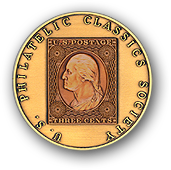
The pioneering work of Dr. Carroll Chase has probably made the 3¢ 1851 stamp the most studied stamp of all time. The specialization of “plating” originated with this stamp.
Plating involves the examination of a particular stamp and determining from which position on the printing plate it originated. This is done by noticing characteristics which are unique to that particular position. The imperforate stamp was produced on plates with two panes of 100 (200 subjects per plate) designated left and right. There were nine plates used to print the imperforate stamp (“0” through 8) and some of the plates were reworked to create various “states.” The various states are early (the original state of the plate), intermediate (a first re-working) and late (the last re-working). If a plate is only re-worked once, it is said to have an early and a late state. Plate position designations are determined by the position (1-100), the pane (left or right), the plate number, and the state (if applicable). For example, the plate position 10R2L means position 10, right pane of plate 2, late state. All of these plates have been reconstructed by Dr. Chase and many students who have followed in his footsteps.
The original hand engraved steel die that produced the 1851 three-cent essay designated “11-E2” in the Scott’s Specialized Catalog, has been donated to the National Postal Museum by a group of 13 philatelists, who pooled their resources to buy it. Only nine copies of the rare essay are known to exist.
To learn more about this Essay, click here to read Roy P. Weber’s Monograph on the subject.
 .com
.comColor Study of the 3¢ 1851-57 Issue, by Cal Hahn

